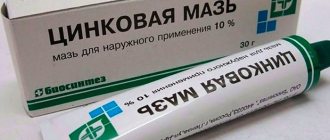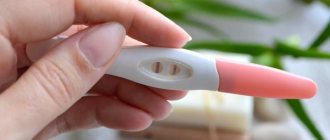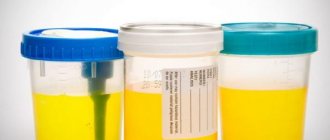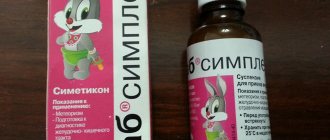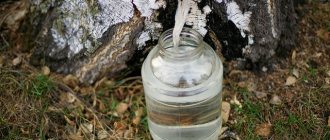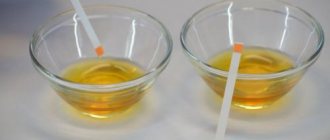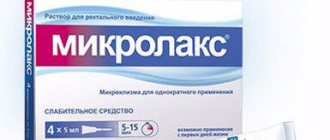Category: tests in children Published 05/06/2018 · Comments: Comments on the post How to collect urine from a girl are disabled · Reading time: 7 min · Views: - 2,213
Tests are an important stage in the prevention of diseases, especially in childhood, when even a slight illness can lead to health problems.
And if you can come to an agreement with older children or figure out how to take the material, then you won’t be able to do this with infants.
It is especially difficult to obtain urine in young children, but it is necessary because it shows kidney function and the amount of calcium and vitamin D in the body.
And if you can try to come up with something with boys, then you need to know exactly how to collect urine from a newborn girl so as not to torment the child.
Introduction to Terminology
A general urinalysis is a routine screening laboratory test of a patient's midstream morning urine sample, which allows one to evaluate:
- 1Physical characteristics - color, smell, level of transparency, density.
- 2Acidity (pH).
- 3Chemical composition - determination of the content in urine of such components as glucose, urobilinogen, protein, ketone bodies, salts, bilirubin, etc. Normally, these substances are not detected in humans or are detected in such small quantities that they are called traces.
- 4The nature and composition of urinary sediment - microscopy of urinary sediment is performed to detect leukocytes, erythrocytes, crystals and bacteria. Thanks to this diagnostic stage, it is possible not only to determine the content of the listed elements, but also to calculate their exact quantity within the field of view of the laboratory technician, which is important in terms of further differential diagnosis.
The analysis is used for early detection of pathology of the urinary system, both congenital and acquired, in children of all age groups.
Sequence of urine collection
Preparatory measures are very important to obtain reliable test results. Therefore, you need to follow all the recommendations so that you do not have to repeat the procedure another day.
First you need to determine what kind of study will be conducted (regular, according to Nechyporenko, or according to Sulkovich). This will allow you to find out what container can be used to collect urine.
According to Nechiporenko
This is a specialized test that determines how well your kidneys are working. Thanks to it, you can accurately determine the presence of problems that are difficult to notice during conventional analysis due to a blurry picture. Such research requires a certain method of collecting material.
How to collect urine from a girl according to Nechiporenko:
- You need to know the duration of urination, and what volumes the baby usually produces. To do this, you need to monitor your child in the days before the test collection. For a more accurate understanding, you can collect morning urine to find out how many milliliters the baby produces.
- When the time of urination is known, it is conventionally divided into three parts - initial, middle and final. Only the middle part needs to be collected for analysis.
Urine separation:
- The first stage is not necessary due to the fact that it may contain foreign inclusions that will affect the result of the study. Therefore, when urination begins, you need to wait a couple of seconds so that the initial urine goes into the diaper.
- The intermediate stage needs to be collected in full, because it is this stage that shows how the kidneys work.
- The final stage is again not needed, and it is poured onto the diaper.
Due to the fact that only the intermediate part of the urine is needed, only collection jars can be used.
Regular and according to Sulkovich
These two tests require the entire volume of urine that the child produces. Therefore, you can use both cans and plastic bags.
At the same time, you should not confuse the test results - the general one shows only normal values that allow you to monitor the child’s health.
The Sulkowicz test is designed to determine the amount of calcium in the urine. If there is too much of it, then this is a signal of excess vitamin D.
Main difficulties
The information content and reliability of the analysis largely depend on when and how the material for the study was collected. It is known that the qualitative composition of urine, as well as its density and chemical structure at different times of the day can fluctuate significantly.
To obtain the most reliable result, it is necessary not only to collect the material correctly, but also to deliver the material to the laboratory on time.
During the collection and transportation stages, parents, especially newborn children, may experience some difficulties, such as:
- 1Inability to accurately predict the time of the child’s next urination.
- 2Inability to explain to the child the need to urinate in the container or container provided to him.
- 3It is impossible to “plant” a newborn or infant over a specially prepared container.
- 4Low awareness of what containers the material can be collected in and how to do it correctly.
Taking analysis using a package from newborn boys and girls
If you are faced with the task of how to collect urine from a baby boy at home, then the answer is simple. There are three ways to collect biomaterial from a boy using:
- urinal;
- glass or plastic containers;
- a regular plastic bag.
What are the advantages and disadvantages of each of them?
Plastic jars for collecting urine are sold in every pharmacy.
How to correctly collect urine from a baby boy immediately into a sterile container?
You can use special sterile plastic jars, which are sold in pharmacies.
For collection, clean small glass containers of baby puree or store-bought mayonnaise may be useful.
They must be sterilized before use. Typically, such jars are kept over steam or boiled for several minutes.
It is more convenient, of course, to use pharmacy plastic jars. Moreover, they are initially sterile, so they do not require any additional manipulations. And you will definitely avoid such unpleasant surprises in the form of leaking liquid.
- First prepare the container for analysis. If the jar was purchased at a pharmacy, unpack it;
- Wash your hands and clean your baby;
- Lay him on a clean oilcloth; you can put a diaper under his body;
- Pick up the jar and wait for the moment when the child begins to write;
- You can stimulate urination by running a small stream of water. Also, eating can contribute to the child wanting to write;
- As soon as the child begins to write, quickly place the prepared container under the stream.
This method is good because it allows you to collect the middle part of urine, which is the cleanest and therefore will show the most accurate results.
But there are also a number of disadvantages here: sterilizing containers at home, if we are talking about ordinary glass jars or buying sterile containers at a pharmacy.
While waiting to urinate, the baby may squirm and kick, so collecting biomaterial may be difficult.
Note that even now this method is the most widespread. And if we go back a little, we collected urine from girls in the following way: they placed a boiled plate under their butts, waited for the result, carefully removed it, and poured the contents into a sterile container with a lid.
If you need to take a Sulkovich urine test on a baby, then you need to know some tricks. It requires collecting a daily dose of urine, but this is very difficult for infants to do.
Therefore, only morning material is collected, before meals. It is better to collect the liquid in a urine bag, this way you can guarantee its cleanliness. Next, it needs to be poured into a sterile jar and taken to the laboratory within several hours. How much urine is needed to test a baby? A third of the jar is enough.
Here you can read about how to collect a urine test according to Nechiporenko, what it shows, and an interpretation of the results.
The following devices are used to collect urine for analysis.
This is the most popular and easy to use device for collecting urine. It is a plastic bag with an adhesive base for secure fixation around the baby's genitals. Such urinals are designed taking into account the gender characteristics of boys and girls and are hypoallergenic.
The advantages of a urinal are:
- Lightweight and easy to use and attach, and the measuring markings allow you to determine the required amount of urine for testing.
- Absolute sterility.
- The best way to collect urine for analysis is from a baby girl, since the attachment point to the skin of the perineum for girls is different from the attachment intended for boys.
- Budget cost.
The disadvantages include:
- The need to transfer collected urine for analysis into another container suitable for transportation.
- Frequent use of a urine bag is not recommended, as a rash may appear where the adhesive part attaches to the baby’s delicate skin.
- Discomfort for the child, since in order to collect urine from a baby girl, it is necessary to carry her in her arms in an upright position.
To collect urine, the urinal should be carefully removed from the packaging, being careful not to damage the device itself, straighten all its corners, remove the adhesive protective tape and carefully attach it to the skin of the child’s perineum.
During collection, it is not recommended to put on the child a diaper and clothes, as the urine bag will be pinched and urine will spill out of it.
This could be a small jar of baby food, juice, food products, or pharmacy plastic urine bags. The most affordable option for collecting urine. Before collection, the container must be rinsed with boiling water or held over steam to further sterilize it.
Before taking the test, the baby should be placed on a changing table covered with a diaper and oilcloth. During urination, the jar is placed under the stream, filling the container without touching the genitals.
This method is not suitable for girls, since it is quite easy to collect urine from a boy’s baby, simply by placing it under the stream. But for girls, it is much more difficult to capture this moment, and the help of another pair of hands is needed to hold the glass container.
A budget and affordable analogue to pharmacy urinals.
The advantages include:
- Availability.
- Easy to use.
- Can be used for both girls and boys.
Main disadvantages:
- The need to transfer collected urine into another container.
- To collect urine, you need to hold the child in an upright position.
- High risk of bag leakage and lack of sufficient urine for analysis.
- The method requires skill to properly collect the liquid.
To properly collect urine using a plastic bag, you need to cut the handles and put them on the baby, making something like a diaper, tying the ends of the bag handles on the baby’s hips.
Despite the available folk methods, it is important to understand that it is better to give preference to pharmaceutical products specially designed for these purposes. It is much easier to collect urine for analysis from an infant boy than from a girl. And it’s easier to carry out the procedure correctly with a pharmaceutical device.
How to collect urine from girls and boys? For many years, people have been using ordinary plastic bags. The operating principle of the bag and the urinal are identical.
To collect samples, we will need a clean plastic bag with handles. Cut the arms in such a way that they can be tied and secured on the hips of the newborn baby.
Thus, we manage to make an improvised urine collector, which is located between the child’s legs.
Further, the entire algorithm of actions is the same as in the case of a purchased urine collector. It is recommended that the child remain in an upright position until urination. If the child is very tiny, then it is recommended to put him in the crib, and put a bag under him; there is no need to wear a diaper. We recommend placing oilcloth under the baby, otherwise you will be guaranteed another wash.
Regular feeding helps newborns urinate more frequently, so try to feed him/her. This will greatly speed up the process.
This method is more budget-friendly than the previous one. In addition, a regular package is almost always at hand, so there should be no problems with collecting tests.
As for the disadvantages, the following are highlighted:
- there is a high probability of spilling the contents if the child is actively moving;
- inconvenience of the procedure performed;
- feelings of discomfort for the child;
- lack of necessary sterility.
This method has another name - grandma's, since it is the oldest and most proven. Previously, containers from mayonnaise or baby food were used to collect samples; today it is possible to purchase special sterile containers for collecting biomaterial.
The algorithm for collecting urine with a jar is as follows:
- wash the child thoroughly and place him on oilcloth;
- pick up the prepared container and wait until the child wants to pee;
- As soon as the newborn begins to have bowel movements, substitute the jar and collect the analysis. It is recommended to collect “average” urine, since it is considered the purest and its research allows you to obtain the most reliable result.
This method is convenient for boys; as for girls, a slightly different method is used for them, called “grandmother’s plate”. The essence of this method is extremely simple.
To sell, you will need a sterilized shallow plate. As soon as the newborn girl pees, the contents of the plate must be poured into a sterile container with a lid.
Everyone will agree that an experienced doctor should decipher the analysis, but some want to know in advance what is wrong with their child.
A change in shade can be observed when new foods like beets begin to be included in the diet, as well as when using certain medications. Urine must have no pungent odor and be transparent; the appearance of turbidity means that the baby has pyelonephritis or cystitis.
The density should be approximately 1002-1004. In order to exclude false results, it is necessary to strictly follow all the rules that were described above. The doctor must be informed about what the child eats and what medications he takes - these factors may affect the analysis.
This can be done using 3 devices:
- special urinal;
- pure polyethylene (diaper or bag);
- clean, sterilized containers (glass or plastic).
To collect tests from a boy in the “traditional” way, you need to prepare a clean, sterile jar (this is achieved by thoroughly washing and boiling it). You can take a thoroughly washed mayonnaise container, but it must have a tightly screwed lid, or buy a disposable container for tests at the pharmacy.
Now you need to strip the boy naked, wash him and wipe him dry. Then you should put the baby on a clean diaper, under which it is better to also put an oilcloth (also clean).
Important nuances
- urinal;
- plastic container;
- plastic bag.
Preparation for collecting material
For analysis, it is preferable to use the “morning” portion, which collects in the bladder cavity during sleep. This reduces physiological daily fluctuations in urine values and allows for more reliable interpretation of the result.
Basic rules for preparing material:
- 1Urine is collected ONLY after preliminary toileting of the external genitourinary organs.
- 2The genital toilet is performed using clean (preferably running) water, from front to back, without the use of detergents. You should not use soap or local antiseptics for washing - this leads to a distortion of the result. In boys, it is necessary to retract the foreskin and rinse the base of the glans penis with running water (unless physiological phimosis prevents this).
- 3After the morning toilet, the baby must be wiped dry with a clean towel. Wiping is done by several successive soft blots. You should not rub the genital area.
- 4Urine collection is carried out only in a clean and DRY container. It is recommended to use special pharmacy disposable plastic containers for these purposes.
- 5 It is recommended to skip the first portion, however, in infants, due to physiological reasons (low volume of diuresis, inability to control urination, etc.), it is permissible to collect all available urine.
- 6For children of a later age who are capable of full-fledged dialogue, the first portion must be drained. The child should be instructed in advance.
- 7It is strictly PROHIBITED to pour urine into a prepared container from a baby potty, or to wring out nappies or nappies. With such manipulations, massive bacterial contamination of the biological material occurs and the result is distorted.
Rules for collecting tests from infants:
- Before collecting tests, you must thoroughly wash the child using special products or soap, and then rinse thoroughly with warm water and wipe dry.
- For analysis, only morning urine should be collected.
- It is strictly contraindicated to donate urine that has been squeezed out of clothing or a diaper. Such an analysis will give a 100% false result.
- It is forbidden to collect urine from diapers; the result will be similarly false.
- You cannot use urine from a pot, as pathogenic microflora develops on its surface.
- It is possible to stimulate urination using the sounds of gurgling water.
- If your baby has been wearing a diaper all night, he will pee in the morning as soon as you take it off.
- A wet diaper on which he lies or a relaxing tummy massage will help the child pee.
- Fresh urine must be submitted to the children's clinic; its storage duration should not exceed two hours.
- A piece of paper must be glued to the jar with the contents, on which all the necessary information will be indicated.
Urine collection in young children
It is difficult for children to prepare material for research before they reach the age of two; it is difficult for parents to explain the rules to their child.
Therefore, there are several tricks:
- 1For infants, especially newborn girls, it is most convenient to collect material in special adhesive urine collection bags. To prevent the urine bag from being pulled off from above, you can wear thick panties, pants or diapers.
- 2 In children 1.5-2 years old who are accustomed to visiting the toilet, it is possible to use the so-called “grabbed” morning portion of urine, which is collected into a sterile container immediately after the start of urination.
- 3Before gluing the urine collection bag, the external genitourinary organs are toileted according to the same rules. The bag should be removed immediately after urination is complete.
- 4If no urination occurs within 30-60 minutes of gluing the bag, it should be replaced with a new one.
- 5Urine collected using adhesive bags is suitable for OAM using test strips, but should not be used for culture.
- 6 Urination in infants is often interrupted and occurs in small volumes. Therefore, it is possible to use several sterile urine bags in a row. To do this, immediately after finishing urination, the bag is immediately removed and the contents are poured into a sterile container. Then the baby should be washed a little with water, blotted with a clean towel and a new clean bag should be glued on. The process can be repeated until the required volume of material for research is collected.
How to collect urine from a baby - video
The video below will help you more clearly understand the process of collecting urine from newborns. With its help, you will form an understanding of how to put on (glue) a urinal bag on a girl or boy. After reviewing it, you will eliminate possible errors in actions.
Modern knowledge and methods of child care make life much easier for young parents. Find out how to properly treat a newborn's navel. Taking advantage of such privileges, you periodically wonder how our grandmothers and mothers lived without being able to easily obtain the necessary knowledge.
We really hope that the information provided helped you choose the most convenient method for you. We will be grateful if you share your experience in the comments, it will definitely help someone. Take care of yourself and your children.
Stimulation of the urination process
Although the process of collecting material for analysis today is somewhat simplified by the presence of special children's containers and containers, often the main problem of parents is the inability to predict the time of the child's next urination.
To solve this problem, it is possible to use reflex stimulation of the process of emptying the bladder:
- 1The process of urination in infants is reflexively associated with eating and drinking, so they can be breastfed or bottle-fed.
- 2 Urination in an infant can also be induced by gentle pressure and stroking in the suprapubic area.
- 3Collecting urine from an infant and a one-year-old baby is sometimes easier to do in the bathroom, “planting” him over the container, that is, giving the baby a semi-sitting position in the arms of one of the parents.
- 4Additionally, to stimulate the process of urination, it is possible to use the sound of pouring water, which also reflexively leads to emptying the bladder.
General collection rules
There are generally accepted rules for collecting urine. They include mandatory hygiene of the baby’s genitals, even if there is no visible dirt and the baby was in diapers all night. The procedure is mandatory for boys and especially for girls, since natural secretions in the urine will increase the readings of leukocytes.
For convenience, sterile purchased containers can be used to collect samples; if you use your own containers, they must be thoroughly washed and treated with boiling water.
How much urine is needed for analysis?
The answer to this seemingly simple question directly depends on the level of equipment of the laboratory to which the material is submitted.
When performing the analysis “with the hands” of a laboratory assistant, the minimum permissible amount of urine is 50 ml. If the laboratory has analyzers - special devices aimed at speeding up and automating sample processing, the minimum volume is much smaller and is about 20 ml.
The same volume will be sufficient when performing express analysis using express test systems (test strips).
Figure 1 — Automatic urine analyzer
As can be understood from the above, it is advisable to know the capabilities of the laboratory where the material for research will be delivered.
Almost all modern laboratories use automatic analyzers, however, if there are deviations in the results obtained automatically, urinary sediment elements are always recalculated manually. This eliminates technical failures and minimizes the number of false results.
Thus, to perform a urine test on an infant, it is better to fill a container of 50-70 ml.
What containers are best to use?
It is best to place the material in a ready-made sterile pharmacy container. You should not purchase non-sterile containers from the pharmacy; they may be contaminated.
See the picture below for what ready-made sterile containers for collecting urine look like. Please note that such containers always have a sterilization date and expiration date indicated on the packaging. Containers without packaging cannot be sterile and, therefore, require pre-treatment.
Figure 2 - Sterile container
For OAM, it is permissible to use reusable, cleanly washed, sterilized with boiling water and dried containers (for example, glass jars). Such containers are still used in some hospitals and clinics.
However, if you are submitting material for bacteriological research, the use of such containers should be avoided, as the result will be distorted. Urine for bacterial culture is collected only in sterile containers.
In infants, disposable sterile urine bags are often used (Figure 3).
Figure 3 - Disposable, universal, sterile container bag
These urine bags have an outer sticky edge that can be used to attach the device to the baby's skin. The hole in the urine bag can be universal, or it can be adapted for boys or girls (Figure 4).
Figure 4 - Sterile urinals for infants (oval hole - universal; ovoid hole - for boys; hole of complex shape - for girls)
Urine collection methods
To obtain the material, there are several methods that have different effectiveness.
In addition to working effectively, each of them has varying degrees of convenience for the child and the parent, so they need to be considered in detail.
For the convenience of collecting and delivering materials, you can use not one, but two methods.
It is important to know that the material cannot be collected by twisting diapers or other fabrics. You should also not use urine obtained from diapers. If an external container is used for collection, it must be sterile.
Urinal
The easiest and most convenient way to take tests is to use special receivers. They are designed to eliminate urine loss, which is very important, because different studies require a certain amount.
The device consists of:
- From a small sterile plastic bag that fits perfectly between the baby's legs. The bag is marked with divisions that show the amount of urine collected, which allows you to determine whether there is enough material for analysis before it is taken to the laboratory.
- There is a special Velcro around the hole for collecting material, which must be firmly attached to the child's skin.
Parents know how delicate the baby's skin is, especially in the groin area. Therefore, they may be worried that something needs to be glued to this place. But the composition of the glue is specially created for children's needs, so its use does not cause skin problems.
Despite the fact that the sticker holds quite tightly (if it is placed correctly and carefully), parents can easily separate it from the child’s skin without causing him pain or anxiety. It’s impossible to remove the girl’s urine bag on her own, so this is the ideal method of collection.
Collecting urine from a girl
Plastic bag
This method is used when it is not possible to buy a specialized package or they forgot to do it.
They take a bag with handles and carefully put it on the baby’s feet. But this method has a number of difficulties that can completely ruin the analysis.
Disadvantages of conventional urine collection bags for girls:
- They do not fit tightly, which is why some of the material may be lost, getting on the skin or flowing down the legs.
- They are of questionable purity and require sterilization. Otherwise, foreign substances or bacteria may get into the analysis (even if a completely new bag is used).
- During the collection of urine, the girl may pass feces, which will completely eliminate the possibility of using the material.
- It is very difficult to secure the bag so that it fits securely on the child without causing him any discomfort.
With a conventional package it is quite difficult to obtain reliable analysis results, while spending a lot of time on it.
Therefore, it is better to use specialized urinals, because urine collection is not required so often, and the purchase of disposable containers will not affect the family budget.
Plastic or glass jar
Sometimes not all urine is needed for analysis, but only a certain part of it, which cannot be collected using a plastic bag.
Therefore, pharmacies sell special sterile jars that are designed for these purposes. They are marked with divisions so that the parent can know the amount of material.
In addition to plastic jars, you can use glass jars, which are found in every home. But they require additional sanitary treatment.
First, they are thoroughly washed with soap and then doused with boiling water. In this case, there should be a metal spoon in the jar so that the temperature of the water is evenly distributed across the glass. This will help reduce the chance of the jar splitting.
Flaws:
- It is impossible to secure the container between the legs, so you will have to hold it. It is important to ensure that it fits snugly, but does not put pressure on the baby’s skin.
- It is necessary to know the time when the child usually relieves himself, because you cannot stand with the container for a long time.
- The participation of two people will be required - one should hold the child in his arms, and the other should hold the container and make sure that the baby does not knock it over with her foot.
If a jar is used to collect urine, the child must be held correctly. When picked up, the pelvis should be slightly lowered, and the girl would seem to be sitting on her forearm.
If this is difficult to do, then the child can be placed on oilcloth and the upper part of the body raised. It is important to remember that babies are not able to hold their head up, so it should be held gently.
Transportation rules
The reliability of the OAM result is influenced not only by the correct collection of the test material, but also by its correct transportation. Basic rules for delivering material to the laboratory:
- 1Transportation should be carried out only at positive air temperatures, otherwise salts may precipitate, which may be mistakenly taken for pathology.
- 2Collected urine is stored for no more than two hours. Prolonged storage of urine at room temperature leads to excessive bacterial growth, destruction of urinary sediment elements and changes in pH. If you need to store more than 2 hours, you can use the refrigerator, but do not forget that freezing urine and excessive cooling are undesirable.
- 3The sample must be delivered to the laboratory closed, with the cap tightly screwed on.
- 4The container must be marked according to the direction. It is necessary to indicate on it the patient’s full name, date and time, as well as data from the referral: office or site number, type of study (OAM), date of birth of the patient. Following this simple rule will help you avoid losing your container. The guide can be attached to the container using a thin rubber band, but this is not necessary.
- 5 During transportation, you must avoid not only freezing, but also heating, shaking and accidental opening of the lid, this will lead to contamination of the material and distortion of the result.
The OAM result is usually ready on the day of delivery in a few hours. In a clinic setting, the result form may be delayed in the laboratory for 1-2 days (the influence of the human factor). In paid laboratories, the period for performing OAM can sometimes be extended; in this case, a special preservative is added to the research material.
Bad advice: what not to do?
- You should not allow your baby to pee on a diaper or nappy and then twist it into a jar. Firstly, a special absorbent located inside the diaper will immediately turn urine into a gel. Secondly, not only will you not be able to squeeze out the required amount of urine from a diaper, but you will also add a whole bunch of tissue fibers to the analysis.
- You should not collect tests from a one-year-old baby by sitting him on a potty or holding a younger child over him, and then simply pour the urine into a jar. You will not be able to sterilize the pot perfectly, and the urine collected in it will contain a high number of leukocytes and bacteria.
- You cannot collect tests in advance, that is, when it is convenient. The effectiveness of the procedure is achieved due to the “freshness” of the tests, therefore they should not be stored for more than 2 hours.
- You cannot neglect the washing procedure, worrying that the child will immediately pee past the jar under running water. Together with the tests, bacteria can get into the container from dirty skin, and the mother’s dirty hands, which she was too lazy to wash, will become another additional breeding ground for infection.
Not recommended:
- Squeeze urine out of a diaper or diaper. Many mothers do not bother with containers, preferring to do just that, forgetting that inside the diaper there is an absorbent that turns the liquid into a gel - and such a substance is not very suitable for delivery to the laboratory. They may not accept it. And the diaper, in turn, “supplies” the analysis with fibers and substances that significantly distort the result;
- Pour liquid from the pot. It is almost impossible to sterilize a pot and make it completely sterile. As a result, doctors will find a large number of leukocytes in the analysis, which is a sign of infection, and parents and their child will have to spend a lot of time in hospitals and purchase expensive medications to treat a non-existent disease;
- Storing urine for more than 2 hours also negatively affects the reliability of the test result.
It is not recommended to use a plastic bag to collect urine; this method is called “unhygienic.” The question of how to collect urine from a one-year-old or three-month-old girl is not difficult - the main thing is to pay attention to hygiene and preparation. To make the process easier, you can buy a urinal bag at the pharmacy.
Young mothers are always surrounded by all-knowing individuals who give a lot of advice, the implementation of which is almost impossible. Let's look at the most absurd of them:
- “Let the child sleep and pee on the oilcloth or diaper, then you can safely unscrew them.” Please note that modern diapers are equipped with absorbents that instantly turn moisture into gel. We very much doubt that such tests will be accepted at least in one laboratory for examination. As for diapers, it will not be possible to collect the required amount of biomaterial from them, even if you put it through a press.
- “Put the child on the potty, and then pour the contents into a container for analysis.” Please note that not a single plastic pot can be properly sterilized; pathogenic microflora always actively multiply there. In this case, boiling water is not the right helper, and cleaning products will not have the desired effect. Urine obtained in this way will consist of an increased number of leukocytes, and bacterial culture will be far from the true state of affairs.
How to decipher the results?
Normal values of TAM indicators in children differ somewhat from those in adults, which is associated with the functional immaturity of the urinary system.
Intrauterine development of the kidneys ends around the third month of gestation. The number of structural renal elements (nephrons) in a newborn is equal to that of an adult (about 1 million), but their structure and morphology are different.
Children have a smaller renal nephron, less permeability of the renal filter, short proximal tubules, this affects the processes of filtration and concentration of urine.
Gradually, as the baby grows, the renal tubules mature, which is why the norms for OAM indicators in children depend on their age.
The table below shows the norms that are used to decipher the result. Next, we will consider the most common deviations in results and their causes.
Table 1 - Standards for deciphering the results of OAM in infants and children after one year
10. “Dirty” analysis
Contamination of collected urine occurs in the following cases:
- 1Poor toileting of the external genitalia before collecting biological material for research.
- 2No drying of the skin.
- 3Pour urine from a child's potty.
- 4Use of reusable containers, plastic containers, insufficiently processed glass containers, wet containers, etc.
- 5 Use of simple plastic bags in infants instead of special urinals.
- 6Overheating of the container before delivery to the laboratory, long-term storage in the light.
- 7 Failure to comply with the terms of application of disposable urine bags (wearing more than 40-60 minutes).
The features of this analysis are:
- 1A large number of squamous epithelial cells in the field of view, sometimes the number of epithelial cells is so large that they cannot be counted by a laboratory assistant. In such cases, they are designated on the study form as “epithelial layers.”
- 2The number of leukocytes, as a rule, is not changed or increased slightly, because there is no process of inflammation.
- 3An increase in protein may be detected in the sample, but the deviation is often minor.
- 4The level of bacteriuria can range from moderate (++) to significant (++++).
- 5 The sample may contain a small to moderate amount of mucus.
- 6Levels of red blood cells, glucose, urobilinogen and ketone bodies are within normal limits.
- 7An increase in density may be observed.
- 8The color of the sample is not changed, but it often becomes cloudy and has an unpleasant odor.
Figure 6 — Contaminated OAM sample
Urinary tract infection
The most common urinary infections in children are cystitis and pyelonephritis. These diseases are infectious-mediated, which means they are accompanied by the presence of not only abnormalities in the TAM, but also the development of clinical symptoms of inflammation.
In early childhood, the symptoms of inflammatory diseases are usually nonspecific, and collecting complaints is difficult, which presents certain difficulties for the attending physician and parents.
That is why OAM is the main screening method to confirm or refute the presence of inflammation in the urinary system.
Differences that allow one to suspect an infectious-inflammatory process in the urinary system in a child are:
- 1Leukocyturia (increased number of leukocytes in the field of view). Abnormalities in the number of white blood cells in the urine directly correlate with the severity of the infection.
- 2Moderate proteinuria (moderate increase in the amount of protein in the urine, not exceeding 2 g/day). The more severe the infectious process, the greater the amount of protein is detected, but no significant deviations in this indicator occur, since the renal filter remains intact.
- 3Microhematuria (slight increase in the level of red blood cells) may be observed. Red blood cells are mostly unchanged. They enter the urine directly in the ureters or bladder.
- 4 In OAM, a large amount of mucus can be detected (more often with urethritis and cystitis). The severity of mucus contamination is indicated on the form using the “+” sign. The more “+” there is in the “mucus” column, the greater its amount in the sample. The maximum value is "++++".
- 5The acidity of urine can shift towards the alkaline side, which is due to the vital processes of pathogenic microorganisms.
- 6Bacteria are always present in the baby’s urine; bacteriuria can vary from “+” to “++++” depending on the severity of the infection.
- 7In case of urinary tract infection, it is possible to detect nitrites, phosphates, and less often other salts (metabolic products of uropathogenic flora).
Figure 7 - Form for urinary tract infection. Leukocyturia, moderate proteinuria, bacteriuria, oxalates are observed
If abnormalities are detected that indicate the presence of an infection in the urinary system, the baby needs to be further examined:
- 1Nechiporenko test - to assess the number of leukocytes and erythrocytes in 1 milliliter of urine.
- 2 Urine culture - to determine the degree of contamination and detect a specific uropathogen.
- 3 Ultrasound of the kidneys and urinary tract - to exclude organic pathology of the kidneys, structural anomalies and stones.
Glomerulonephritis and nephropathy
Glomerulonephritis and nephropathies of various origins are diseases characterized by damage to the glomerular apparatus of the kidneys without involving other parts of the urinary system.
Most often, the pathology is based on autoimmune damage to the glomeruli due to the deposition of damaging immune complexes on their membranes.
At the initial stages, the disease occurs with minimal clinical manifestations, which increases the informativeness of TAM for confirming the diagnosis. Early detection of glomerulonephritis and autoimmune nephropathies can prevent the development of severe renal failure.
Suspicion of the presence of damage to the glomerular filter arises from the following deviations in the TAM:
- 1The main role is played by an increase in protein levels in the urine (proteinuria). The severity of proteinuria can range from moderate to significant, which is associated with a violation of the filtration process of blood plasma proteins.
- 2Hematuria (increased number of red blood cells in the urine) is no less significant. Red blood cells are mostly changed. The severity of hematuria varies from microhematuria (invisible to the eye) to macrohematuria (pink and red coloration of the sample).
- 3The content of leukocytes and epithelium is most often within normal limits.
- 4With long-term damage to the renal glomeruli, a decrease in urine density is observed, which is due to a violation of concentration processes.
Figure 8 — OAM in a child with chronic glomerulonephritis
With long-term nephropathies, a child may develop the so-called nephritic syndrome, when massive proteinuria is accompanied by edema, a decrease in blood plasma protein levels, and an increase in vascular pressure.
Swelling occurs in the face (eyes) and ankles, then spreads and becomes denser. Generalized edema and anasarca are observed in severe cases of the disease.
A child with suspected glomerulonephritis/nephropathy undergoes further examination, including:
- 1Urine analysis for daily proteinuria - to assess the degree of daily protein loss.
- 2 Nechiporenko test - for quantitative counting of red blood cells and leukocytes in 1 milliliter of urine.
- 3Zimnitsky test - to determine the concentration ability of the kidneys.
- 4Determination of glomerular filtration rate.
- 5Ultrasound of the kidneys - to exclude organic pathology of the renal tissue.
- 6Biochemical blood test (BAC), with mandatory determination of the level of total protein, albumin, urea and creatinine.
- 7Determination of the level of pathological immunoglobulins, circulating immune complexes, antistreptococcal antibodies.
- 8The most accurate result is achieved with a puncture biopsy of the kidneys. Although this study is not always available, it allows us to most accurately determine the type of glomerulonephritis and select adequate treatment for the disease.
